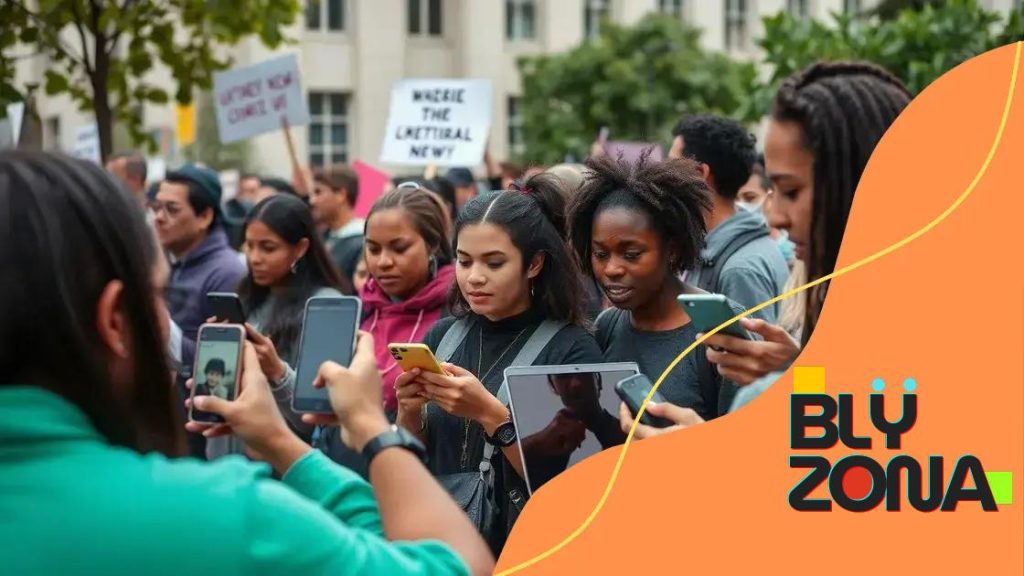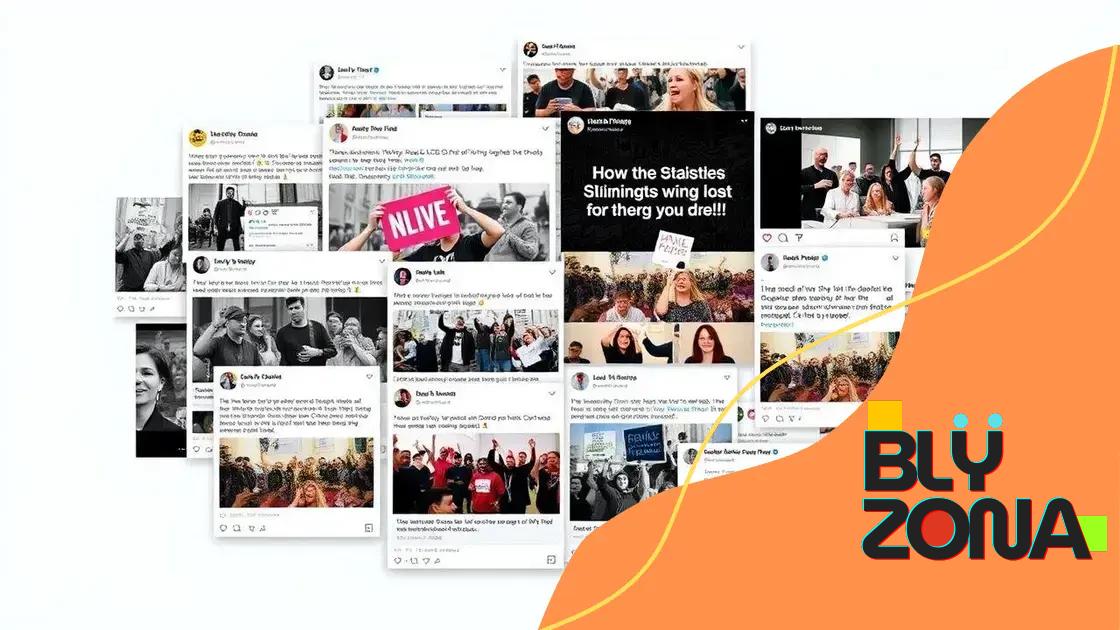Digital activism and social change movements: your guide

Digital activism and social change movements leverage online platforms to mobilize communities, raise awareness, and advocate for social justice, despite challenges like misinformation and online harassment.
Digital activism and social change movements are rapidly transforming how individuals and communities interact with social issues. Have you ever wondered how technology fuels these movements? Let’s dive in!
Understanding digital activism
Understanding digital activism involves exploring how technology and social media shape our engagement in social movements. This new form of activism is not just about online petitions or hashtags; it’s about leveraging digital tools to create real-world change.
As we dive deeper, it’s important to recognize the various elements that make digital activism effective. From mobilizing communities to raising awareness, digital activism harnesses the power of connectivity.
Key elements of digital activism
There are several key elements that contribute to the success of digital activism. Understanding these can enhance participation and impact:
- Accessibility: Making information available to everyone, everywhere.
- Engagement: Encouraging active participation and dialogue among supporters.
- Awareness: Using social media to inform about pressing social issues.
Another essential aspect is the role of social media platforms. They have become primary channels for disseminating information and gathering support. Many movements today rely on platforms like Twitter, Instagram, and Facebook to reach a wider audience quickly.
The impact of storytelling
Storytelling plays a pivotal role in digital activism. Narratives humanize issues, allowing supporters to connect emotionally. Effective advocacy often includes sharing personal experiences or testimonials, which can resonate deeply and inspire action.
Moreover, the use of visuals is crucial. Images, videos, and infographics can convey powerful messages that text alone may not achieve. This visual communication can create a sense of urgency and importance around an issue.
As you reflect on digital activism, consider how you can utilize these strategies. Engaging with current issues through digital platforms can help link your voice with others committed to social change.
Key strategies for effective online movements
To achieve success in online movements, it’s essential to implement effective strategies. These strategies can help strengthen the message and increase participation. Let’s explore some key approaches that will enhance your digital activism efforts.
Engagement through social media
Social media plays a vital role in mobilizing support for online movements. It allows activists to reach a broader audience quickly. Engaging with followers through comments, polls, and shares fosters a sense of community.
- Use hashtags: Create memorable hashtags to enhance visibility.
- Post regularly: Consistent updates keep followers informed and engaged.
- Respond to comments: Interaction encourages continued dialogue and investment in the cause.
Another critical strategy is building partnerships. Collaborating with other organizations or influencers can amplify your message and provide access to larger networks. Additionally, leveraging different platforms maximizes reach.
Storytelling to connect
Utilizing storytelling is another powerful strategy. Sharing personal stories can create emotional connections with audiences, making the cause more relatable. Compelling narratives can inspire followers to take action and contribute. Visual content, like videos and images, can enhance these stories, making them more impactful.
Finally, measuring the impact of your strategies is vital. Analyzing engagement metrics can help determine what works and what doesn’t. Adjusting your approach based on feedback ensures continued growth and relevance of your online movement.
The role of social media in activism

The role of social media in activism is crucial for creating change. It allows activists to connect with a global audience instantly. Social media platforms not only spread awareness but also mobilize action. Through likes, shares, and comments, people can engage with important issues and join movements.
Amplifying voices
Social media provides a platform to amplify voices often unheard. Various movements utilize these channels to share stories and experiences. This exposure can lead to greater support and understanding of social issues. Additionally, hashtags create trends that draw attention to causes.
- Increased visibility: Hashtags can make issues trending topics.
- Community building: Activists can find like-minded individuals and create supportive networks.
- Immediate feedback: Engagement allows activists to understand public sentiment quickly.
Furthermore, social media campaigns can lead to real-world action. Online petitions, fundraising, and event planning happen on these platforms. A single post can inspire thousands to participate in rallies, demonstrations, or discussions.
Challenges of social media activism
While social media is powerful, it also presents challenges. Misinformation can spread rapidly, misleading the public. Activists must be diligent in sharing accurate information to maintain credibility. Balancing online activism with offline efforts is also essential. Online engagement should complement real-world actions for lasting impact.
In conclusion, the role of social media in activism is transformative. It empowers individuals to connect and engage in meaningful discussions around pressing social issues.
Case studies: Successful digital movements
Case studies of successful digital movements showcase how online activism can drive change. These movements highlight innovative strategies and demonstrate the power of community engagement in achieving goals.
Movements that made an impact
One notable example is the #MeToo movement. Initiated on social media, it raised awareness about sexual harassment and assault. The hashtag quickly went viral, encouraging people to share their experiences. This led to widespread discussions on workplace behavior and policies.
- Awareness raising: The movement highlighted the prevalence of abuses.
- Community support: Many found solidarity with others who shared their stories.
- Policy changes: The movement led to significant changes in workplace policies.
Another compelling case is the Ice Bucket Challenge. This campaign was designed to raise funds and awareness for ALS. Participants poured ice water over themselves and nominated others to do the same, all while donating to research. Its fun, engaging format became a worldwide phenomenon.
Lessons learned from these movements
These case studies reveal important lessons for aspiring digital activists. First, simplicity is key. Movements that have clear messages tend to resonate better. Second, involving personal stories can create emotional connections among followers. Lastly, leveraging existing platforms for viral trends can maximize reach and participation.
Lastly, the success of these movements showcases the power of collective action. When individuals unite online, they can challenge societal norms and advocate for meaningful change. Effective use of hashtags and storytelling can energize communities and lead to significant outcomes.
Challenges faced by digital advocates
Digital advocates often encounter various challenges in their efforts to promote social change. Understanding these obstacles is crucial for developing effective strategies. Issues such as misinformation, online harassment, and digital divide can hinder progress and impact the effectiveness of their activism.
Combatting misinformation
Misinformation can spread rapidly on social media platforms. This can mislead the public and undermine the credibility of important campaigns. Activists must be vigilant in sharing accurate information and correcting false narratives to maintain trust.
- Fact-checking: Ensuring information is verified before sharing is essential.
- Sources: Citing credible sources helps build authority.
- Education: Informing followers about recognizing misinformation can create informed communities.
Another significant challenge is online harassment. Many digital advocates face threats and abuse for their activism. This can lead to burnout, causing some to withdraw from public discourse. Support systems are vital in helping activists cope with these negative experiences.
Addressing the digital divide
The digital divide also poses challenges for digital advocates. Access to reliable internet and technology is not equal for everyone. This disparity limits participation from marginalized communities, weakening the overall impact of movements. Ensuring that all voices are heard is crucial for effective advocacy.
Advocates need to work towards inclusivity, finding ways to engage and empower those with limited access to technology. Solutions may include providing resources, organizing training, or creating accessible content that reaches diverse audiences. By recognizing these challenges, digital advocates can develop strategies to address them and continue their important work in promoting social change.
FAQ – Frequently Asked Questions about Digital Activism
What is digital activism?
Digital activism uses online tools and social media to advocate for social change. It connects communities and raises awareness about important issues.
How can misinformation affect online movements?
Misinformation can spread quickly on social media, undermining the credibility of movements and misleading the public on crucial issues.
What are some successful examples of digital activism?
Movements like #MeToo and the Ice Bucket Challenge illustrate how digital activism can mobilize people globally and raise awareness for social causes.
What challenges do digital advocates face?
Digital advocates often deal with challenges such as online harassment, misinformation, and the digital divide, which can limit participation from marginalized groups.





